Persian Influence on Greek architecture
The ancient Persian and Greek cultures did not exist in isolation. There was cross-fertilization. The present article describes several aspects of Persia's influence on Greece.
Architecture
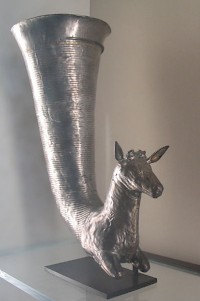
The Greek buildings we're about to discuss, were all built after the Persian general Mardonius had destroyed Athens in 479 BCE, and after the battles of Salamis, Plataea, and Eurymedon, where the Greeks had in their turn defeated the Persians. The Athenians had obtained much wealth after these battles. Herodotus tells that after the battle of Plataea
the Greeks dispersed themselves about the Persian camp and found tents furnished with gold and silver, and beds overlaid with gold and overlaid with silver, and mixing-bowls of gold, and cups and drinking vessels [i.e., rhytons]. They found also sacks laid upon wagons, in which there proved to be caldrons both of gold and of silver; and from the dead bodies which lay there they stripped bracelets and collars, and also their swords if they were of gold, for as to embroidered raiment, there was no account made of it.note
When a Persian king went to war, he not only took his army with him, but many courtiers as well. In this way, he could also live like a king when he was at the front, and was able to give fitting rewards to his brave warriors.
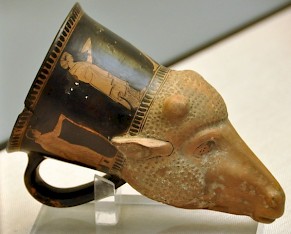
After the Greek victory, the booty was divided between the towns and cities that had shared in the fighting, and everybody received a fair share. So did Athens. As one of the leading powers, it must have been one of the first to choose, and as a consequence, much silver, gold, and other luxuries were brought to Athens. A simple but excellent example are the Persian rhytons (drinking vessels with animal shapes), which appear in Athens suddenly and in great quantities after the war. They were immediately imitated by other Greek artists.
Except for precious metals, utensils and luxuries, weapons and tents were taken away from the battle field at Plataea. Especially the royal pavilion, in which Mardonius had had his lodgings, had the full attention of the Athenians.
Architecture: Odeon
It is certain that after Plataea, the pavilion of the great king was taken to Athens. But what happened next? It has been assumed that (a part of) it was already used in 472 BCE as theatrical scenery of Aeschylus' The Persians. Another suggestion - not necessarily contradicting the preceding one - is that the wooden structure was used as a music hall (odeon) and later rebuilt from stone. This can be deduced from the following words by the Greek author Plutarch of Chaeronea:
The Odeon, or music room, which in its interior was full of seats and ranges of pillars, and outside had its roof made to slope and descend from one single point at the top, was constructed, we are told, in imitation of the king of Persia's pavilion [skênê]. This was done by Pericles's order.note
It is not surprising that the pavilion was used as a piece of scenery or/and music room. After all, Athens had been sacked and emergency accommodation and temporary buildings are to be expected. Besides, the pavilion of Xerxes was not a family tent, but a portable palace.
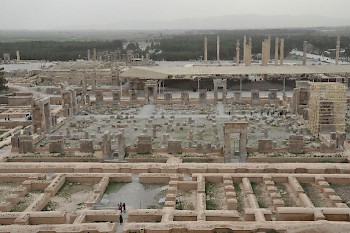
When the Odeon of Pericles was excavated, it turned out to have almost the same dimensions as the Hall of the Hundred Columns in Persepolis, the capital of the Achaemenid Empire. The Odeon measured 68,50 x 62,40 meters and contained 9 x 10 columns; the room of the Persepolis palace had 10 x 10 columns and measured 68,50 x 68,50 meters. The similarity is too obvious to be coincidental. The pavilion must have been a copy of the Hall of the Hundred Columns, and the Odeon must have been a copy of this copy.
It should be noted, however, that this Persian example was not really followed in Greek and Roman architecture. The acoustics of the Odeon of Pericles must have been terrible. Later odeons were small theaters and not square halls.
Architecture: Prytaneum
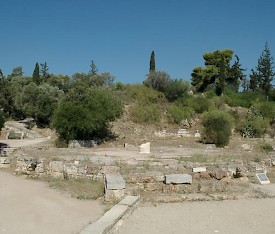
The prytaneum at the Athenian market (agora) was the building where the prytaneis, the executive committee of the Athenian democracy, gathered. Built in 465 BCE, the building had the form of a circle and was very simple, without much ado. The Athenians called it simply the tholos ("round building") or skias ("parasol"). It is therefore probable that the building looked like a parasol and had a round, pointed roof.
The Persian king and his satraps were often portrayed with a parasol. It has therefore been assumed that the Athenians used Persian left-behinds (e.g., a royal tent) and reconstructed it in a more durable material, retaining the original form, just like the Odeon of Pericles. This assumption gains credit when we take into account that round buildings were extremely rare in the period before the Athenian prytaneum was built. There were, of course, round buildings, but they were always surrounded by stoas - something that is certainly not the case with the tholos.
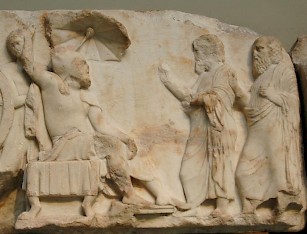
Again, we may assume that the Athenians used the Persian spoils. And again, the influence of this model was not lasting. Later prytanea were built differently.
Architecture: Parthenon frieze
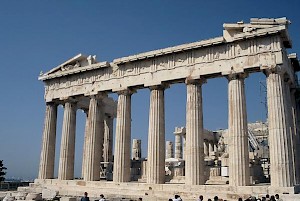
Our next subject is completely different. The Parthenon frieze, just like the Pathenon itself and the Athenian owls, has become a symbol of the Greek world and its culture. They represent Athens at the zenith of its power and at its best. The fact that the way of representation may be un-Greek, makes the frieze no less impressive and certainly more important.
The construction of the Parthenon, one of the great building projects of the Athenian leader Pericles, started in 449 BCE. As temple of Athena, the city's protective deity, it was the place par excellence where the Athenians could show what they thought of themselves, their town, and their goddess - and they were proud. They had every reason to be so. Their fathers had defeated the Persians (480-479), and the city was rightly famous for this victory. Besides, the economy was functioning well, and Athens was the leader of the Delian League, a position that it used unhesitatingly to impose tribute.
Once, the Athenian leader Aristides had organized the League as a confederacy of equal states with equal rights (isonomia), but in the decades between 479 and 449, Athens had seized the initiative and had started to regard the other towns as subjects. Rebellions against the tribute had mercilessly been repressed. Athens possessed the means to do this, because it had used the tribute to built the largest army and navy in the Greek world.
The Athenians had every reason to build a temple worthy of the powerful goddess that had assisted them in their gaining power. Therefore, the Parthenon was the best place to show the world why the Athenians and Athena were the best rulers of the Greek world. An ambitious project by an ambitious town.
In these years, people started to speak of an "Athenian Empire", and perhaps the Athenians were looking for inspiration to the other superpower of their age: Persia.
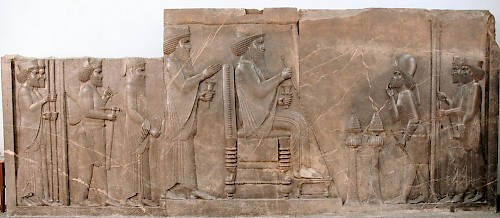
Some seventy years earlier, the Persian king Darius I the Great had started to build one of the palaces where he and his court were to stay: Persepolis. Here the king received guests and subjects; here he lived his official and private lives when he was in Persis; here he stored his treasures. Craftsmen and specialists from all parts of the empire were invited to come and help building the palace, such as Yaunâ (Greeks from Ionia), who were well-known for their expertise in sculpture. Although we cannot have absolutely certainty that the Ionian Greeks are the makers of the reliefs discussed below, it is reasonable to assume this, since no other nation in the Achaemenid Empire was capable of the perfect rendering of the human body.

The relief under discussion can be found on the eastern wall of the stairs of the audience hall, which is usually called Apadana. On the relief we can see how the subject nations come and visit the great king and bring their tribute. They approach from the left, and every ambassador is accompanied by a Persian courtier; they are introduced to king (Darius) and crown prince (Xerxes) by a high official (who has been identified with Pharnaces). Behind the king are noblemen, horses, chariots, knights, and guardsmen. Everything is ready to begin. The ambassadors and the men behind the king are talking and correcting their dresses. The highest official is about to introduce the first ambassador.
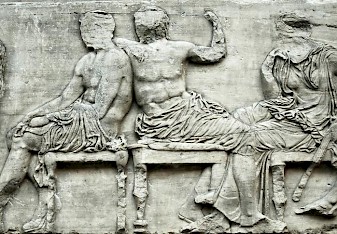
Now let's compare the relief of the Apadana at Persepolis to the frieze of the Parthenon in Athens, which is currently in the British Museum in London (the Elgin Marbles). Here we see the Panathenaea, the yearly festival in which the Athenian citizens visited the statue of Athena. Every four year, they offered her a new cloak (peplos). At the end of the procession, on the western side of the sanctuary, are the knights, then we see chariots, citizens, the carriers of the objects needed during the ceremony, victims, and the officials of Athens. On the eastern side, above the main entrance of the temple, the gods are already waiting to receive the offerings.
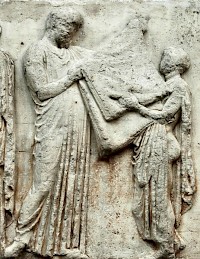
In the central part of the frieze, the old peplos is folded up, a footstool is brought for the ritual king and queen of Athens (the basileus and basillina), and everybody is waiting for the ceremony to begin. People in the queue are talking to each other, horses are calmed down.
Both reliefs are tripartite, and the central parts are the most important. The other two parts, flanking the central composition, also show strong similarities. At the extreme ends, we see the last partakers in the processions, e.g., horses and other animals. There is much space allotted to them. More to the center, the people become more quiet, are placed closer to each other. Here, turned heads or stretched arms are the only visible actions. The central panel, where Darius and Xerxes or the basileus and basillina are visible, is larger and more spacious. This composition forces, so to speak, the spectator to look to the center of the relief.
It is possible to make another tripartite division. In both works of art, the picture is that of a central figure, an entourage surrounding him, and people approaching him. (In the Parthenon frieze, the entourage consists of gods and the folding of the peplos.)
Another resemblance is their placing: they are both situated on the spot where the ceremonies actually happened. This must have caused a special effect. The Athenian spectator was not just looking at a beautiful picture with an obvious symbolism, but recognized something that he had experienced himself. The Persepolis relief created a similar involvement of the spectator, although at a larger scale. But those who saw the relief on the Apadana, knew instinctively that they belonged to this procession of subjects, belonged to the Achaemenid Empire, and had to contribute to its strength. This solidarity was of course what the great Achaemenid empire, or any nation that wanted to be great, needed. Of course, the depicted unity was not necessarily real, but an ideal.
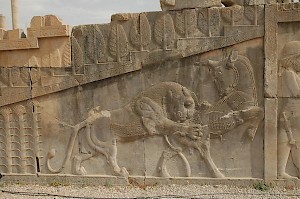
The Parthenon is not a purely religious building. The frieze is also a political statement, inviting the citizens to remain united. But this is not the only message. Elsewhere, on the metopes, we can see a battle between Amazons (dressed as Persians) and Greeks that is usually interpreted as a mythological reference to the war between Athens and Persia, and a deep insult to the Persians, who could not be offended more than by being called "woman". We can also see gods fighting against giants, Greeks against centaurs, and Achaeans against Trojans. (Similar representations of the war between the powers of chaos and order can be found in Persepolis, where we find pictures of a bull and lion.) All this served to present the Athenians as valiant warriors, the equals of the gods and the legendary heroes.
The Parthenon also had a function as treasury of the Delian League and a reserve fund. For example, every tributary town was supposed to send an ambassador to the Panathenaea and offer a cow and a panoply. This was again similar to the Persian example, because one of Persepolis' main functions was that of treasury. Both buildings, Apadana and Parthenon, were an empire's focus points of politics, religion, and finance, and it is possible that Athenian artists had learned from their older Ionian colleagues how the great king had invited his subjects to be his collaborators.
Architecture: Erechtheum
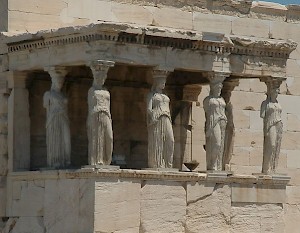
Another example of the emulation of artistic ideas can be found in the Erechtheion on the Athenian acropolis. It was built after the Parthenon, between 425 and 409, during the war against Sparta. For the present purpose, we are interested in only one part of this complex sanctuary: the caryatids.
In one of the wings of the Erechtheion, these female figures carry the roof on their heads. They are not the first examples of this type of column in Greece: the caryatids of the Siphnian treasury at Delphi were, according to several art historians, erected immediately after the Greek victory over the Persians in 479 BCE.
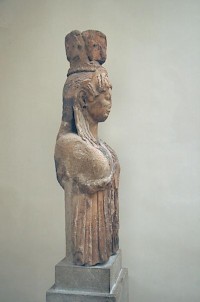
The issue is how and from where these women were introduced into Greek art. One explanation is offered by Vitruvius, a Roman architect who published a textbook On Architecture. He writes:
Should any one wish for information on the origin of those draped matronal figures [...] called caryatids, I will explain it by the following story. Carya, a city of Peloponnese, joined the Persians in their war against the Greeks. These in return for the treachery, after having freed themselves by a most glorious victory from the intended Persian yoke, unanimously resolved to launch a war against the Caryans. Carya was taken and destroyed, its male population extinguished, and its matrons carried into slavery. To ensure that these circumstances might be better remembered, and the nature of the triumph perpetuated, the victors represented the matrons draped, and apparently suffering under the burden with which they were loaded, to expiate the crime of their native city. Thus, in their edifices, did the ancient architects, by the use of these statues, hand down to posterity a memorial of the crime of the Caryans.note
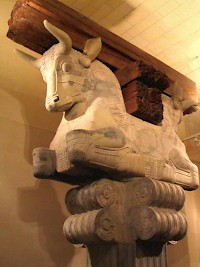
In other words, caryatids are not only statues with the function of columns, but express an idea: you were not supposed to collaborate with the enemy, because you would be subdued, humiliated, and punished.
This motif is also known from Persia. In the second half of the sixth century BCE, the great king had assembled a great many conquered nations. These people, or rather their subjection, became part of the royal imagery. To express the idea that others were subjected, the Persians used no human but animal figures. For example, the imposts of the columns in the palaces (the top of a column which connects it with the supporting beams of the roof) often have the shape of of a bull or a winged feline. The analogy is obvious: like a griffin or a wild bull under a yoke, the nations were kept under control by the king.
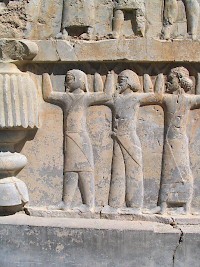
Sometimes, humans are depicted as carriers of a great weight: for example, on the royal tombs at Naqš-e Rustam and Persepolis, we see the king, standing on two large platforms. These platforms are carried by men, who probably resemble the subject nations. Another example is the representation of the king on the Tripylon-gate at Persepolis, where the king is sitting on a throne, supported by three levels of humans.
The Athenian caryatids do not resemble ordinary Athenian women: their hair cuts are uncommon and resemble Peloponnesian hair cuts. This is something we can say with certainty. But when we try to establish a Persian influence as well, we have to be more speculative. Why didn't the Athenians copy the animal figures and did they use women instead?
If we ignore the possibility that the Athenian men treated their women like animals - which is certainly a possible interpretation - the solution may be that the Athenians only emulated the general idea behind the representation. In the Persian context, yoked animals or people are carrying a great weight, which was apparently seen as the essence of subjection. The same element can be found in the Greek situation: the caryatids are carrying a heavy load. This time, they are not animals but women, but this has a reason: as we have seen in the example of the Parthenon frieze (above), the Athenians adapted a general idea to a specific situation. They used a concrete example, the shameful subjection of the women of Carya, to show that they were prepared to subject people, as the Persians did.
This was not merely an intention, but the Athenians put it into practice. In the next section, we will deal with their imperialist policy. In the years after the Persian Wars, Athens expanded its empire and controlled a great part of the Greek world with its superior navy. This created new problems in the management of the empire, and the Athenians wanted to deal with them as efficiently as possible. Probably, they looked abroad how the Achaemenids had solved the same problems. Of course it is possible that the Athenian leaders were original and creative thinkers, but, as we shall see, there are indications that they copied Persian solutions.